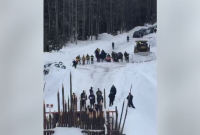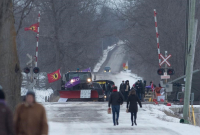Support strong Canadian climate journalism for 2025
Rumours, confusion and cynical speculation are swirling online in the wake of the clash between the Wet’suwet’en and the RCMP, the latter of which is aggressively enforcing a court injunction to allow construction of the Coastal GasLink pipeline on unceded land:
"Most Wet'suwet'en are on board with the project."
"The protesters are foreigners paid by organizations bent on killing the oil and gas industry."
"The hereditary chiefs have no authority."
"The elected band councils have no authority."
On and on it goes.
Meanwhile, offline, all across Canada, acts of civil disobedience — daily demonstrations and indefinite railway blockades — continue to proliferate as Indigenous people and their allies rise in solidarity with the Wet’suwet’en.
But what about the real Indigenous Peoples, in the communities that stand to be directly affected by this multibillion-dollar fracked-gas project?
And what about those living on Wet’suwet’en traditional lands — lands they consider sacred, among the last remaining pristine areas on Earth, offering pure mountain air, clear and healthy water and vast, wild lands where their ancestors are buried? What do they make of the promise, peddled by the pipeline’s backers, that they’ll receive instant liberation from poverty and that no harm will be done?
I spoke with Wet’suwet’en Hereditary Chief Namoks (a.k.a. John Ridsdale) on Tuesday. He’s told me I’m welcome to call him anytime. Friendly and easygoing, he’s a maintenance man by day, when not acting in his ceremonial capacity, as he has been frequently depicted in the media of late, wearing his stoic regalia and leading the rebellion against the pipeline.

I put it to him straight out: people are saying that his office is funded by foreign interests and he's doing this all for the money.
He laughed: “I wish I was getting paid!”
He said the office of the Wet’suwet’en is a non-profit: they aren’t funded by the feds like elected band chiefs, but they do take donations. They need money to survive day to day like anyone else. But, he added, they don’t act on behalf of any donating organization. The Wet'suwet'en are obligated to stand up for the lands, he said, because it’s their law to protect those lands and ensure their use for future generations. Wet'suwet'en law is what binds them as a people, he explained: it’s spiritual, and without their law, they would cease to be Wet’suwet’en.
Recently, I texted my colleague, a talented and committed photojournalist who had lived at the Unist’ot’en healing camp for more than a month, documenting everything, before leaving on Tuesday. Because she has spent long periods of time with the front-line protesters and land defenders in a very intimate environment, I wanted to know what she had to say about all the internet conspiracy theories.
Is it true that these people are mostly far-removed outsiders paid by the global environmental elite?
There are several Wet’suwet’en members there, she said, sometimes in rotating shifts. Other land defenders do come to stay and help at the camps, too. Some are Indigenous, some are not, and they’re welcomed. They provide their own resources to be there, though. It’s not easy for everyone to give up their day jobs and their families to be on the front lines, she explained.
An article going around says that Molly Wickham, who has been a mainstay at Unist’ot’en for years and a spokeswoman during many of the protests, isn’t a Wet’suwet’en band member, but has been adopted in.
I’m not sure about Molly not being a Wet’suwet’en band member, but if she’s adopted in, that’s considered a very sacred ceremony and a person becomes like a blood relative — it’s like this in many Indigenous communities.
The article claims she’s from Stellat'en First Nation. I went there, too, and did a profile. Stellat’en is a small, poor community that’s famous for the legend of the sasquatch. One member even pointed out over the mountain behind his house where it’s believed the sasquatch lives — sometimes, they hear him screaming in the distance.
Stellat’en is pretty, well-kept and looks like a picturesque mountain village. It operates a bountiful community garden the size of a baseball field in the summer. And it’s not too far down the highway from the Wet’suwet’en — maybe a two-hour drive.
Their main water source, the Stellaquo River, is polluted from the nearby copper/mineral mines — they can’t drink from it or eat the fish. It’s filled with arsenic. The chief, Arthur Patrick, told me there was nothing else for the band anymore, so they signed a Mutual Benefit Agreement with CGL, but he wasn’t too happy to be involved — it just was what it was.
I met a group of Stellat’en elders, who all had varying opinions. Some of them were hereditary chiefs of that nation. Some were enthusiastic, some were cautious and some were fervidly against — we all sat together and talked about it in a sharing circle.

Another — the Nak'azdli First Nation — an hour and a half northwest of Prince George, next to the largest natural body of water in B.C., Stuart Lake, also signed a Mutual Benefit Agreement with CGL.
Their chief is a soft-spoken, progressive-speaking, businessman, Alex McKinnon. He’s elected under the Indian Act. Alex is helping to lead the community on various economic development projects. They have a state-of-the-art greenhouse and grow fresh food for the Nak'azdli, selling remnants for profit to several grocery chains. The forestry industry there is dying, he said.
I went to his home and met two of his children. His youngest daughter was dancing around the house and bringing me pictures she’d colourfully drawn. His newer modular home is heated by a wood-burning fireplace and overlooks the breadth of Stuart Lake, framed by mountains with rock carvings drawn thousands of years ago by his ancestors.
The Province of B.C. and CGL tout the “overwhelming” support from all 20 elected First Nations along the pipeline route.
Alex told me it was the hardest decision of his life when he made the call to vote in favour of CGL.
It was to break a tied vote among his council. The community was torn. It was years in the making. It kept him up at night, tossing and turning.
He and his hereditary chief, Peter Erickson, told me, from the comfort of Peter’s cabin home that he shares with his wife and teenage daughter, the Nak'azdli were “backed into a corner” by the Province of B.C. and told to sign on, or they’ll get nothing and it “will happen anyway.”
I met with a beautiful Nak'azdli mother who works on the nation’s environmental monitoring team, Rose Marie Sam. She’s thankful to be able to monitor the construction CGL is doing in Nak'azdli territory. She doesn’t want it, but she wouldn’t have had rights in the past, so she said she’s grateful.

Just 40 minutes south of the community is the infamous Highway of Tears, where dozens of women, mostly Indigenous, have gone missing or been found murdered since the 1970s. She doesn’t ever drive that road alone — this is her home and she won’t go there alone.
Now, more industrial camps are coming — camps that have been linked to violence against Indigenous women by the National Inquiry into Missing and Murdered Indigenous Women and Girls final report released June 2019.
There was a worried look in her eyes when she spoke of the spirit of the land, its history and its future significance. Her concern for its potential plundering was strong. She often prays for the land, the future and even the CGL workers. She prays all continues to go well and environmental disaster will never arrive at their doorstep.
They’re already working to protect their salmon — the runs continue to dwindle year by year as it is. The pipeline will run right through the Salmon River — a waterway utilized for millennia by her ancestors. There are ancient Nak'azdli trails along the bush lines near the river that once served as trade routes of ceremonial value.

Then, I met with the Haisla people on the northwest coast in Kitimat. Elected Chief Councillor Crystal Smith cried and cried in my interview with her. But she also smiled bright and stood proud while sharing her nation with me. It's a breathtaking fortress nestled among the snow-topped coastal mountain range. The ocean hosts massive subsistence for Haisla like salmon, hooligan fish, killer and humpback whales, seals and more in its unadulterated waters. Black and grizzly bears and eagles are plentiful and sightings are the norm. Wildlife often share the resources of the land and water to hunt and feed alongside the Haisla down at one of the beaches or the great rainforest, which is also facing environmental danger.

Crystal’s a mother, too. She’s young, feisty and business savvy. She’s convinced that the CGL pipeline is a saviour for her community, which struggles with poverty and lack of economic opportunity. Their fisheries are running low — this will bring hope for them. It’s their right to say yes to a project, too, as Indigenous Peoples, she said.
Crystal told me she and the Haisla are bullied by some First Nations opposing the development. She’s been called colonized, a traitor, a sell-out and other names that shouldn’t be repeated. She told me her safety has even been threatened at times.
I met Haisla environmental manager and band member Candice Wilson. No surprise, she's a mother, too. Candice has a beautiful, gentle, welcoming smile. Her house is perched atop a mountain edge overlooking the coastal territory of her ancestors in Kitimat Village. She fed me hooligan fish and dried seaweed in her dining room. I felt honoured and privileged to be there.
Candice has a heart for the land and waters.

The Haisla did not go into this partnership with CGL lightly. Again, it took years of negotiations and environmental-impact studies before they gave the go-ahead. The Haisla believe that the CGL LNG plant being constructed on the shores of their sacred territories will be safe and not provide a major impact to marine life, water and the air, because they’ve conducted stringent environmental-impact studies and Candice has worked with CGL to oversee them.
She used to travel to a remote island via a three-hour boat ride up the coast toward the open ocean as a young woman. Elders, teachers and Haisla members utilize a remote island out there. It’s a place where her ancestors went to pray. She’s conducted ceremonies there that were transformational. She has had spiritual experiences on the land, she told me, because she connects to her creator best on the land.
The CGL project weighs heavily at times. And Candice did tell me there are many things that remain uncertain regarding the monitoring of the environment and they don’t know how it may play out yet. Yes, the chance of gas leakage or increased oil tankers disrupting the fragile ecosystems could be devastating — but to the Haisla people, it’s worth the risks because there are not many alternatives to help them prosper.
These were only four nations that I visited and profiled. There are 16 others along the CGL pipeline route, all with varying stakes, opinions and dealings with the project — but they were all passionately aware of the implications on all sides, good and bad.
These are all sovereign, separate nations — even within the Wet’suwet’en, which contains five bands. And these are people that historically are connected to the land, clamouring to heal from the effects of colonialism and all its ills, while reclaiming what was lost and healing in a time of what’s supposed to be reconciliation.
For so long, Indigenous Peoples have felt they’ve had no voice in Canada. Just less than 50 years ago, their rights would’ve been completely trampled and they would’ve received nothing in exchange for governments and industries to use their lands and resources.
This is pretty new territory — negotiating benefits, consultation and working together with governments and industry. But the conflicts and removal of Indigenous people from their lands like we’re seeing with the Wet’suwet’en has been ongoing since contact — nothing new.

CGL has said it’s working to change the broader reputation of past industry dealings with Indigenous Peoples.
Rick Gateman, president of the Coastal GasLink pipeline project, said in a press release in September 2018 that the company’s goal was to build more than “just relationships” with First Nations in B.C. “It was to build trusted partnerships, and that has made all the difference,” he said.
Right now, those endeavours are looking pretty strained.
This pipeline project and showdown with the Wet’suwet’en is exhaustively complicated — more than the average person can understand just by reading an article slamming or hailing one side over the other, dotted with rumours and misconceptions of the people affected. It involves digging deeper. A lot deeper.








Comments
From what I've read, it's not so complicated. The elected bands have jurisdiction on their reserve lands. The Indian Act says so. The hereditary chiefs have jurisdiction on the much wider traditional lands of the Wet'suwet'en. Delgamuukw and other court cases say so. Anyone can understand how elected bands and hereditary chiefs alike would like to lead their people out of grinding poverty, but decision-making jurisdiction needs to be respected. A lot of us also understand how there are climate-destroying and otherwise environmentally risky extraction projects, as well as other kinds of projects that do not herald destruction. How great it would be if Indigenous peoples could come together with financiers to develop economic plans for renewable energy projects and other money-making ventures that don't involve climate and environmental risks.
Right on Dianne!...in a perfect world. But I guess the reality is individuals having to make tough decisions in the context of poverty, individual lives, and environmental degradation.
The Wet'suwet'en hereditary chiefs proposed two alternative routes but CGL rejected them. See https://www.cbc.ca/news/canada/british-columbia/wetsuweten-coastal-gasl….
Yes, I've heard this too, but what I heard was only one alternative route was proposed and rejected. And, Coastal GasLink makes a big deal on their website of collaborating with the Wet'suwet'en on the route of the pipeline.
Such a respectful, care fully constructed report! Thank-you Brandi for helping us all to try to dig much, much deeper into all the complexity and heartbreak and victory contained in this and these stories. Not easy but I sense so necessary to hold it all. Thank-you.